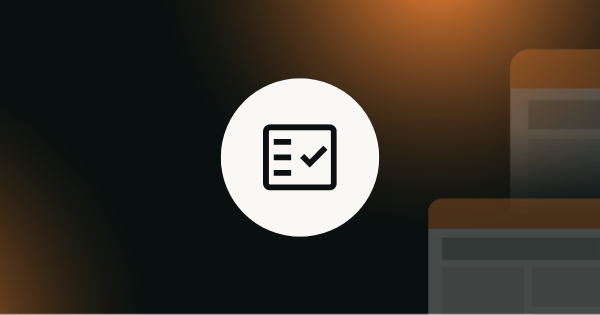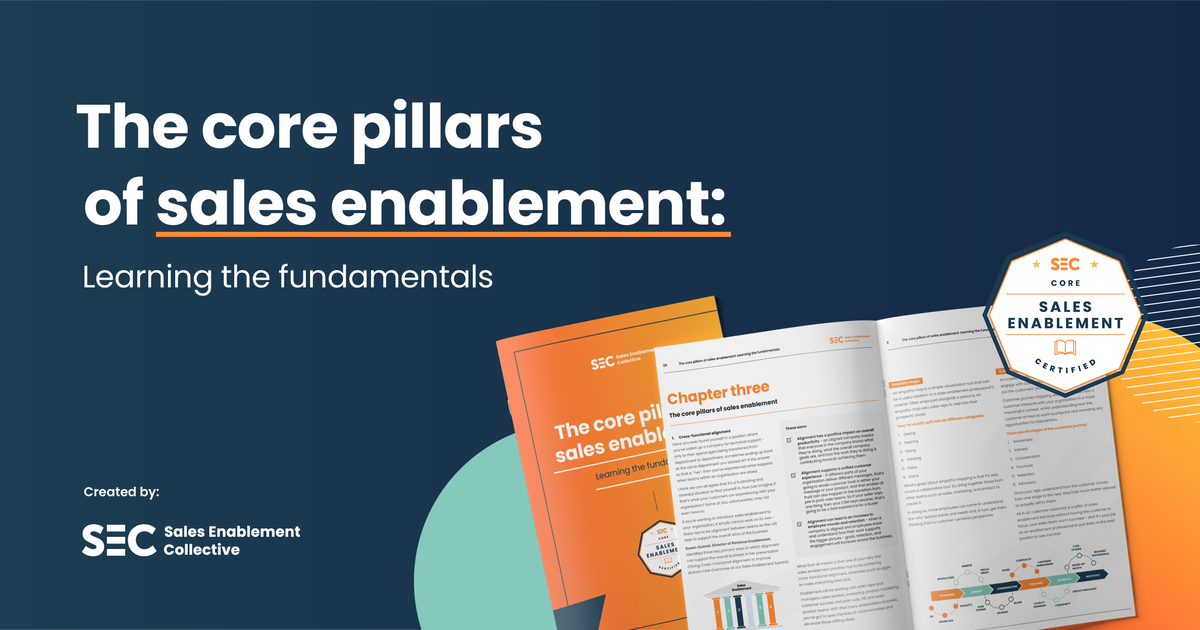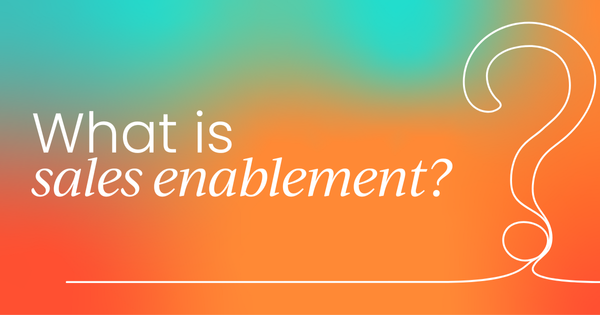What is sales enablement?
Sales enablement is a strategy which encompasses coaching, training, content, technology, processes, and all other activities with the aim of supporting and empowering sales reps to progress sales opportunities through knowledge-based interactions with prospects.
The simple version: Sales enablement is about providing salespeople with support and training to help them be better at what they do.
Sounds easy enough, but there’s more to it than meets the eye. A good sales enablement department will work with key stakeholders to ensure:
- New sellers are onboarded quickly and efficiently.
- There’s quality sales content for sellers to use.
- That sellers know which pieces of content to use (and when).
- That seller performance is tracked so sellers know where they need to improve.
- The company’s sales kick-offs are engaging and effective.
- Sellers have the fewest possible barriers during the sales cycle and in their day-to-day role.
- That good sales training and coaching is going on.
- Cross-functional communication between the marketing team and the sales team is efficient.
- That the organization’s long-term sales enablement strategy is sound.

While specific responsibilities vary from role to role, you get the idea. Sales enablement departments work on improving and maintaining some of the most critical, revenue-driving aspects of an organization.
What isn’t sales enablement?
So, there’s our sales enablement definition. But sometimes things are better understood by taking a look at what they’re not.
Most importantly, sales enablement is not sales operations.
Sales operations deals with the processes, the technology, and the overall backend to the sales experience. That means things like setting up automations in the CRM (Customer Relationship Management software), and training salespeople on how to use the software and tools that help them to do their job. Enablers might sometimes work with the SalesOps team, but their responsibilities are distinct.
There’s also a distinction to make between sales enablement and sales training, or sales coaching.
How is sales enablement different from sales training and coaching?
Sales training is all about sales itself; teaching salespeople to sell better. Such skills will be universally applicable to anything the salesperson goes on to sell in the future.
B2B sales enablement is about providing salespeople with specific information and knowledge that’ll help them to sell a specific product more effectively. Your sales enablement content, and your enablement workshops, are unlikely to have much, if any, carryover to future roles your salespeople hold.
Why is sales enablement important?
Sales enablement is important because, as a function, it dedicates itself to supporting and empowering sales reps. Empowered sales reps:
- Display increased sales confidence.
- Are more likely to improve their performance.
- Provide a better customer experience for prospects.
Multiplied across your entire sales team, this can lead to increased revenue.
And, as you’ll know, the buyer journey no longer starts at the first contact with the seller. Nowadays, potential customers are well-informed before they ever interact with your sales team.
If your sales reps aren’t prepared for that, you’ll fall behind the competition. They need to be kept up to date with the latest developments in buyer behavior, and sales enablement plays a crucial role.
Sales success is about more than just training and coaching sellers in the short term to improve their skills. It’s about having a long-term, strategic sales enablement process in your organization that ensures your sellers are equipped with the knowledge they need to speak authoritatively about your products, as well as those of your competitors.
Do this, and watch your reps discover their newfound ability to communicate why yours is the only real solution for each individual prospect.
In turn, you’ll see your sales teams close more deals and bring in more revenue. And what could be more important than that? 🤑

What is the goal of sales enablement?
Sales enablement exists to increase the profitability of an org’s sales team. That’s the key goal.
As you can imagine, increasing win rates means increasing the effectiveness of each sales rep on payroll. More won deals means more revenue. As such, enablement can be excellent for a business’ bottom line.
But increasing win rates isn’t the only way an enablement team can increase your sales team’s profitability.
Here are some of a sales enablement professional’s responsibilities that also lead to increased revenue:
- To successfully onboard reps.
- To improve sales confidence.
- To boost sales win rates.
- To aid sales teams with their biggest challenges.
According to our survey for the 2023 Sales Enablement Landscape Report, 62.16% of enablement teams are responsible for onboarding new sales reps, while a staggering 95.95% of enablers are at least partially responding for onboarding.
Why might this be?
Onboarding is directly tied to the “time to productivity” metric. That is, how long does it take for a new rep to come into the company and start effectively selling, more than offsetting the cost of bringing them into the business?
Improving the confidence of sales reps is another core responsibility, and is tied to profitability in a number of ways.
First, a more confident sales rep is a more comfortable, relaxed sales rep. More confidence means less anxiety, more freely flowing conversations, and better performance under pressure. As sales is a performance-based role, it’s common for underperformers to churn. The hiring and training process costs a business money, so turning an underperformer into a reliable rep is another way enablement teams can increase overall team profitability.
Enablement teams can instill this confidence in a number of ways. Providing strong enablement content, is one way of doing this.
What is sales enablement content?
So, the creation and maintenance of sales content is another part of the sales enablement job description. The Sales Enablement Landscape Report 2023 found that over 75% of enablement teams are at least partially involved in the process of creating this content.
Sales content, sales collateral, and sales enablement content (these terms are often used interchangeably) gives reps the ammunition they need to handle common objections, speak authoritatively about problem competitors, and frame your product as the ideal solution for the prospect.

This content comes in different shapes, sizes, and formats.
From one-pagers that sales reps can give to prospective customers, to battlecards that reps can use to get the lowdown on their competitors before a sales call.
Simply put, sales enablement content contains information for either a sales professional or prospective customer to view, which provides them with a better understanding of your product or service, and convinces the prospect of the value of that product or service.
Reporting and analyzing your sales enablement results
Sales enablement works. According to G2, “organizations with sales enablement achieve a 49% win rate on forecasted deals, compared to 42.5% for those without”.
But how do you know your efforts are working? And, even if you’re convinced they are, how do you make a convincing case to your bosses that you deserve the investment you’ll need to achieve your career goals?
Measuring sales enablement can be difficult — it’s often tricky to tie a new onboarding program directly to an increase in new rep ramp time, for example. And how do you prove that your new content management system has led to easier access to content — and therefore increased usage?
The answer is to pay attention to key sales enablement metrics. Here are the top five metrics enablers use to measure the success of their function, according to our 2023 Sales Enablement Landscape Report:
- Content usage. (50%)
- Win rates. (40.54%)
- Quota attainment. (39.19%)
- Sales cycle length. (29.73%)
- Pipeline growth percentage. (28.38%)
The importance of content adoption rate
The most widely adopted metric enablement teams use to measure success, according to our data, is the rate of adoption for enablement content. A whole 50% of enablers use this metric to measure their own success.
Here are some reasons why this is important:
First, content adoption is easy to measure. All reps need to do is report whether they use the content they’re given, and whether they believe it helped in the outcome of a deal.
Second, content adoption is an input-related metric, and the closest thing to a leading indicator of success you’ll get. Your enablement team can directly control how much enablement content they produce, and its quality. Metrics like win rates and sales cycle length are lagging indicators of success, since deals may take months to close.
Third, low content adoption rates can signal wasted enablement efforts and, importantly, a general lack of cohesion amongst the sales team.
A lack of cohesion in the sales team
Enablement content doesn’t just deal with competitors. It also serves as a delivery method for key deliverables from the product marketing team, like your positioning and messaging strategy.
Product positioning and messaging change over time, so your customer-facing teams need to be kept abreast of any updates to the way you’ve decided you’ll speak about your products or services.
This is because it’s crucial your prospects experience a coherent, congruent customer journey. If only some of your reps are using the content you produce, such cohesion is off the table, and usually points to a lack of alignment within the team.
In practice, this means different reps giving prospects different takes on where your product shines, what its strengths are, who it’s for, and what position you occupy in the competitive landscape.
This is a problem. You want the same message drilled into your prospects at every touchpoint. It makes your brand seem more reliable, more trustworthy, and more worthy of your prospect’s money.

Who owns sales enablement?
So we understand a bit more about the function and its goals.
But who does the work sit with?
In smaller companies, there’s often no dedicated enablement team. Instead, multiple departments (either formally or informally) handle the enablement responsibilities. Primarily, marketing, product marketing, and sales will take on the responsibility to ensure sales reps have content that helps them sell the organization’s product or service, and that sales leadership is providing adequate coaching for underperforming reps.
At larger businesses with the budget for a dedicated enablement function, you’ll have solo sales enablers, or even entire teams dedicated to ensuring reps are receiving top-class support.
According to last year’s Sales Enablement Landscape Report, the most common size for enablement teams is between 2-4 people, with 33.8% of our survey takers reporting being part of a team in this size bracket.
How to perform sales enablement
So… how do you do sales enablement? If you’ve been tasked with building an enablement function, how the heck do you do it?
Step 1: Align with the C-suite
First, you need to get a sense of what the business’ goals are. When it comes to enablement, this is often simple: “Sell more products. Make more money.” But it’s not always so cut and dried.
It’s always worth checking in with the leadership team. This might just mean perusing documented files that outline your company goals. At a small startup, though, this might mean sitting down one-on-one with the CEO.
The name of the game here is to figure out:
- Where the organization is right now.
- Where the org wants to get to.
Then, it’s up to you, the sales enablement professional, to figure out how you can help make that happen.
Step 2: Time for a Listening tour
Now, you need to get a sense of what the problems are. These are the blockers currently preventing the company from moving from point A to point B as defined in step 1.
To understand the problems, you need to listen to your stakeholders. That includes your sales reps, but it also includes other departments around the business. Product marketing might have already tried some enablement with little success.
Such information can be invaluable.
Take “listening” literally, too. Listen to recordings of sales calls for the most objective view of what might be going on during conversations with prospects.
Listen hard, read between the lines if you have to about what the problems are, before seeking to offer solutions.
If you get the solution wrong because you didn’t listen well enough, you’ll waste time producing the wrong stuff, and you risk having reps follow guidance that hurts performance rather than helps it. There’s no surer way to damage your reputation, so take your time with this step.
Step 3: Get stakeholders on board
The message to convey is this: You’re here to help. Not to get in the way.
You’re there to help reps earn more commission, experience less stress and anxiety, to feel more confidence, and to more consistently achieve their goals.
“Seek first to understand, then to be understood” is the fifth habit in Stephen Covey’s bestselling book, “The 7 Habits of Highly Effective People”. If you want people to see your point of view, first show them you understand theirs.
When you take your time in Step 2, and are able to show your stakeholders that you understand their frustrations by communicating them back to them in your own words, you’ll find people much more willing to try out your solutions when you eventually present them.
Step 4: Start building solutions
You know where you are, and where you want to get to. You have a good idea of what’s standing in the way of you getting there. So it’s time to start removing those blockers, and that means building solutions.
Now’s the time to start creating enablement content. You may have to work cross-collaboratively at this stage, which is why it’s so important to have buy-in already.
Collate the information your reps need to handle objections more effectively, or deal with tough competitors when they come up in conversation, and deliver it to them in the way they’ve told you should be most useful.
Step 5: Start delivering those solutions
Hold workshops and deliver content with your content management system (CMS) to get reps the information they need, when they need it.
At this point, it’s really crucial that your reps are bought in, or that all important metric, the content adoption rate, will be abysmal. You’ll have gone to all that effort of building solutions for the problems your reps face, and it won’t matter. No one will be engaged during your workshops. No one will use the content you’ve built.
When your reps are on board, however, they’ll be aware of your work before you bring it to them. They’ll be checking in, and offering feedback when you ask for it. They’ll help you shape the ultimate enablement solution for them, and they’ll help you iterate and improve on future versions, too.
And that’s crucial: Your first version is not your final version.
Don’t fret about getting something perfect over the line. If it helps a little bit, it has done its job. So long as you keep listening, future versions will be better.
Looking for next steps?
So you know how to perform sales enablement in principle, but do you have a strong enough mental model of the function to navigate its challenges with confidence?
Our eBook guides you through the core pillars of sales enablement. Check it out. 👇

What are sales enablement tools?
Sales enablement professionals adopt a wide array of tools and technology to help them in their role.
These include content management and learning management systems, AI-powered conversation intelligence tools, all-in-one sales enablement platforms, and more.
These tools help sales enablers support reps more effectively at scale.
There’s a lot of depth to this conversation, which is why we have an entire article dedicated to running through the various types of sales enablement technology and tools you’ll hear about in the landscape.
What is revenue enablement, and how does it differ?
If you’ve joined in on any conversations across the enablement community, or attended our events, you’ll probably have heard the term revenue enablement.
But what is revenue enablement and where did it come from?
Essentially, organizations began realizing that the principles behind sales enablement were incredibly sound. For that reason, they began to expand from solely empowering and supporting the sales team, to looking at the entire customer-facing, revenue-driving part of the organization.
Now, you’ll often find more mature enablement organizations dropping the “sales” label and going by revenue enablement, taking the marketing and customer success teams under their wing.
This ensures that there’s total alignment between what the prospect is experiencing pre-sale, during the sales process, and post-sale in their interactions as a new customer.
What about go-to-market enablement?
It’s the same story with go-to-market enablement. Why stop with the customer-facing teams if enablement is so effective?
Organizations that employ go-to-market (GTM) enablement extend that level of support to any department involved in that GTM process of launching a new product or service, including product and often engineering teams too — in addition to the teams covered by revenue enablement.
Where does buyer enablement fit into this?
Buyer behavior has changed, and continues to change. While sales enablement is one part of the equation in adapting to this change, “buyer enablement” is also a part of this adaptation.
The idea of buyer enablement involves bringing that same level of empowerment that reps receive from sales enablement, to buyers.
Buyer enablement is part of a larger move to a buyer-centric selling paradigm. You have to understand a buyer’s preferences before, during, and after they buy if you want to provide them with the best experience possible.
Getting hired as a sales enablement manager
Becoming a sales enablement professional can be a deeply rewarding career path. Your job involves helping others achieve their potential, and assisting those who are struggling in their role. What’s more, your work is closely tied to revenue, so annual salary review conversations should be a breeze.
There's also a creative element when it comes to designing content and training sessions, as well as aspects of project management and data analysis. There's something for everyone!
Thinking this could be the role for you? Learn all about sales enablement manager salaries, or check out our in-depth guide to getting hired in the industry.
Still looking for next steps?
Don't worry, our eBook isn't going anywhere.
But a few clicks are all that separate you from discovering:
- Exactly what sales enablement is (and what it’s not), so you can start doing it the right way. ✅
- The five core pillars of sales enablement (plus a special bonus pillar that’ll help you to work faster and more efficiently). 🔑
- A simple-to-understand mental model of the sales enablement function, giving you clarity and confidence as you navigate enablement challenges. 💡
Discover the pillars now. 👈


Sales enablement insider
Thank you for subscribing
Level up your sales enablement career & network with sales enablement experts
An email has been successfully sent to confirm your subscription.
 Follow us on LinkedIn
Follow us on LinkedIn






